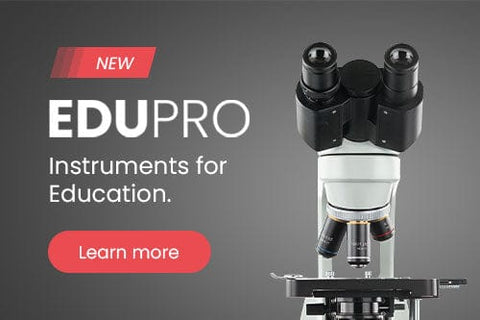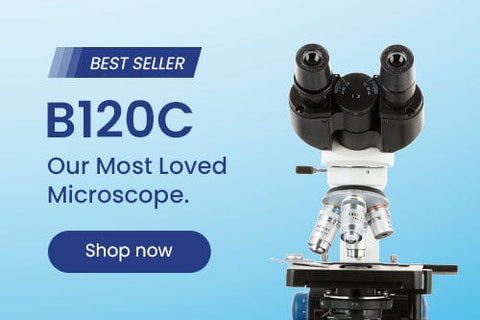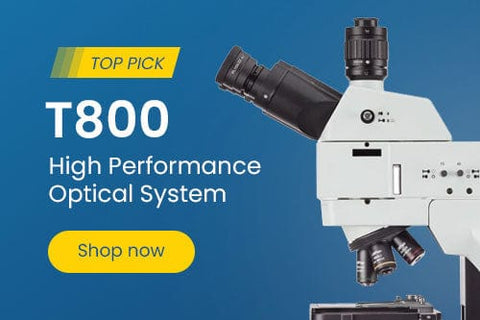- Microscopes
- Cameras
- Lab Supplies & Equipment
- Shop By Brand
- Lab Supplies by Category
- Analyzer Consumables
- Balances
- Bags
- Beakers
- Bench Scale Bases
- Bottles
- Bottletop Burettes
- Bottletop Dispensers
- Boxes
- Blank Microscope Slides & Cover Slips
- Blood Collection
- Caps
- Carboys
- Centrifuges
- Centrifuge Tubes
- Cold Storage
- Containers
- Cryogenic Vials
- Culture Tubes
- Cylinders
- Dispensers
- Digital Dry-Baths
- ESR Products
- False Bottom Tubes
- Flat Bottom
- Funnels
- Gel Documentation
- Glassware
- Glass Test Tubes
- Histology
- Homogenizers
- Hotplates-Stirrers
- Inoculation Loops and Spreaders
- Liquid Handling Products
- Manual-Electronic Pipettors-Pipettes
- Microscope Slides
- Overhead Stirrers
- Pipette Controller (Serological Filller)
- Pipette Tips
- Plastic Test Tubes
- PCR Tubes, Strips & Plates
- Racks
- Repeater Pipettor
- Rockers
- Rotary Evaporators
- Serological Pipettes
- Shakers
- Spectrophotometers
- Syringe Tips
- Sample Tubes
- School/Classroom Supplies
- Screwcap Test Tubes
- Self-Standing
- Test Tube Racks
- Test Tubes & Vials
- Transport & Storage Tubes
- Thermal Mixers
- Transfer Pipets
- Urinalysis
- Vacuum Pumps
- Weighing Dishes
- Lab Equipment
- Balances
- Bench Scale Bases
- Centrifuges
- Digital Dry-Baths
- Gel Documentation
- Homogenizers
- Hotplates-Stirrers
- Overhead Stirrers
- Pipettors
- Rockers
- Rotary Evaporators
- Shakers
- Serological Pipettes
- Spectrophotometers
- Thermal Mixers
- Vacuum Pumps
- Liquid Handling Products
- Manual-Electronic Pipettors-Pipettes
- Pipette Tips
- Racks
- Pipette Fillers-Controllers
- Repeater Pipettor
- Syringe Tips

Cost effective products and solutions designed to improve laboratory efficiency, safety and results.
SHOP BENCHMARK SCIENTIFIC >
- Slides & Accessories
- Slides
- Cameras
- Illuminators
- Adapters
- Eyepieces / Objectives
- Bulbs
- Magnifying Lamps
- Monitors and Tablets
- View All Categories
- Adapters
- DSLR Adapters
- USB Camera Adapters
- Ring Light Adapters
- Power Adapters
- Barlow Lens
- Books & Experiments Cards
- Bags & Cases
- Bags
- Cases
- Cameras
- Circuit Board Holders
- Cleaning Kits
- Condensers
- Darkfield
- Phase Contrast Kits
- Polarizing Kits
- Dust Covers
- Eye-Guards
- Eyepieces
- 20mm
- 23mm
- 30mm
- 30.5mm
- Filters
- Microscope Filters
- Illuminator Filters
- Fluorescence Kits
- Conversion Kits
- Filter Cubes
- Focusing Racks
- Fuses
- Illuminators
- Bulbs
- LED Illuminators
- Fiber Optic Illuminators
- Fluorescent Illuminators
- Ring Lights
- Stand Lights
- Goosenecks
- Gooseneck Attachments
- Immersion Oils
- Loupes
- Magnifying Lamps
- Clamp Lamps
- Desktop Lamps
- Rolling Stand Lamps
- Mechanical Stages
- Monitors and Tablets
- Calibration Slides & Stage Micrometers
- Stage Warmers
- Stain Kits
- Stands
- Articulating Arm Stands
- Boom Stands
- Table Stands
- Tweezers
- Other Accessories
- Shop By Industry
- Shop By Industry
- Botany
- Agronomy & Forestry
- Horticulture
- Phytopathology
- Chemistry
- Biochemistry
- Biotechnology
- Cannabis
- Pharmaceutics
- Consumables
- Beer & Wine
- Cosmetics
- Food & Beverage
- Electronics
- Circuit Boards & General Electronics
- Mobile Phone Repair
- Semiconductors & Wafers
- Environmental
- Asbestos
- Ecosystem Research
- Mud Logging
- Soil Treatment
- Water Treatment
- Forensics
- Ballistics
- Fingerprint Analysis
- Genetic Identification
- Hair & Fiber Analysis
- Handwriting Analysis
- Industrial
- Aerospace
- Automotive
- Dental Lab & Production
- Glass Industry
- Industrial Inspection
- Mechanical Parts
- Paper Industry
- Petrochemical
- Plastics
- Printing Industry
- Quality Assurance & Failure Analysis
- Textiles & Fibers
- Tool Making
- Wood Production
- Jewelry & Gemology
- Engraving
- Gemology
- Jewelry Repair
- Stone Setting
- Watch Repair
- Hobby
- Coins & Collecting
- Stamps
- Modeling & Assembly
- Sculpting
- Repair
- Telescopes
- Metallurgy
- Archaeology
- Geology
- Mining
- Petrology
- Medical & Microbiology
- Anatomopathology
- Bacteriology
- Biochemistry
- Cell Culture
- Cytology
- Dental Microbiology
- Dermatology
- Dissection
- Gout & Rheumatology
- Hair & Fiber Analysis
- Hair Transplant
- Fluorescence
- Hematology & Live Blood Analysis
- Histopathology
- Mycology
- Medical Devices
- Microsurgery
- Neuropathology
- Oncology
- Parasitology
- Pathology
- Semen Analysis
- Virology
- Veterinary & Zoology
- Breeding & Semen Analysis
- Entomology
- Fecal Smears & Floats
- Marine Biology
- Ornithology
- Veterinary Medicine
- Zoology
- Shop By Industry
- Students
- Telescopes
- Buy With Prime
- Sale
- Compound Microscopes
- Shop By Brand
- AmScope
- Euromex
- Omax
- Shop by Head Type
- Binocular
- Monocular
- Trinocular
- Multi-head & Training
- Shop By Specialty
- Brightfield
- Darkfield
- Phase Contrast
- Inverted
- EPIfluorescence
- Polarizing
- Digital Integrated
- Metallurgical
- Shop By Application
- Education
- Research
- Veterinary
- Compound With Digital Head
- Shop Best Sellers
- Shop All Compound
- Stereo Microscopes
- Shop By Brand
- AmScope
- Euromex
- Shop By Objective Type
- Fixed Power
- Zoom Power
- Single Lens
- Common Main Objective
- Shop By Stand Type
- Articulating Arms
- Boom Stands
- Gooseneck Stands
- Table Stands
- Other Stands
- Shop By Head Type
- Binocular
- Monocular
- Trinocular
- Simul-Focal
- Shop By Industry
- Video Inspection
- Industrial Inspection
- Microscope Heads
- Shop Stands
- Articulating Arm
- Boom Stands
- Table Stands
- Stereo With Digital Head
- Shop Best Sellers
- Shop All Stereo
- Specialized Microscopes
- Digital Microscopes
- Kids, Student Microscopes
| AmScope Blogs
Basic Microscopic Techniques in Food Analysis
The U.S. Food and Drug Administration (FDA) made it mandatory for manufacturers to label their consumable products with an ingredient list in 1993. By regulating the Nutrition Facts that appear on the side of every processed food, consumers can make informed decisions regarding their health and lifestyle choices, while also being able to easily sidestep ingredients that cause allergic reactions. What was once guesswork is now taken for granted by the average grocery shopper.
So where do microscopes come into play? They can be used to verify the authenticity of published ingredients, but they also serve many other food analysis and safety functions between production, packaging and consumption. Below, we discuss some of the ways in which basic microscopic techniques are used in modern food analysis.
Foreign Materials
There are a lot of stops along the line between farm and fork, where foreign materials may enter a food product. Foreign objects are of course dangerous for the consumer and often lead to massive recalls. Foreign object-related recalls reached an all-time high in 2018, with an average of one case per week. Some instances, like a single metal shard found in ready-to-eat chicken, are most likely still in the public’s memory due to sheer size. This recall affected about 20 tons of meat produced by Wayne Farms. In another instance, a worldwide recall of chocolate bars affected 55 countries when Mars pulled their product after over a piece of plastic embedded in their confection.

These types of recalls are still far fewer (and generally lead to fewer injuries, illnesses and deaths) than recalls due to contamination. However, the economic impact that massive recalls have on companies can be just as severe as an E. coli outbreak. This is one of the many reasons companies are turning towards stereo microscopes and other microscopy techniques for extra safety measures, in addition to the X-rays and other preventative tactics already in place. Severe lacerations to the throat, mouth and/or intestines caused by a foreign object found in food could be a death knell for even a well-established company.
False Advertising
Another massive and altogether alarming issue facing the food industry is intentional mislabeling. Chances are, you remember hearing about the horsemeat fiasco in Europe a few years back. Random testing of frozen hamburgers in several grocery store chains turned up evidence that a considerable percentage of the hamburgers were not beef at all, but were comprised of a horse. The same problem happened with meatballs from IKEAs in several countries. Perhaps the most bothersome part of these stories was that they were separate incidents that were not traced back to the same facility. While many European countries may be more tolerant than the U.S. in eating unconventional meat, the false labeling of meat is a huge concern.
HPLC chromatography can be used to separate food into its molecular components in order to determine content. Slight variations in the molecules can be used to determine whether the meat is bovine or equine in origin. Additionally, digital imaging can also help researchers collect more data on food quality in general. Further testing utilizing a microscope camera can provide answers to even more questions, such as whether tilapia labeled as crab contains one of the myriads of parasites or diseases that those fish are prone to. Six billion pounds of seafood is imported to the U.S. each year, much of which comes from countries with largely unregulated aquaculture practices. The National Oceanic and Atmospheric Administration (NOAA) is working to increase scientific data collection on imported seafood to help combat false reports. While basic microscope techniques can help with spot-checking imports, it’s impossible to inspect every shipment that comes in when the numbers are that large.

Pests
Sometimes pests enter our food, and even if they pose no real threat, they are usually not a welcomed sight. Insect parts can be inadvertently mixed into food at nearly any stage of production. They can be carried in on vegetables or fruits straight from the farm, fall into cooking vats or cutting mechanisms or live bugs can work their way into packaging and set up a community during long-term storage. Bulk grains and legumes are particularly common homes for certain insects, which may often be found still alive by the time they make it to your kitchen. The most effective measures against this happening rely mostly on building management, both at the production and storage levels. Keeping the building free of pests goes further to remedy beetles in your lentils than monitoring techniques, especially since they can be moving targets. However, X-ray analysis from a scanning electron microscope may also help detect pests or objects in hard, opaque packaging.
Pesticides
Microscopes can be used to detect the presence of pesticides in certain foods. Pesticide residue testing takes many forms, one of which can be comparing molecular structure of a product to determine if any pesticide residue shows up in fats and oils. Microscopes are also used to analyze tissue samples of plant matter, where certain degradation can be an indicator of pesticide use.

On the back end, the Environmental Protection Agency (EPA) tests the toxicity of certain pesticides and fertilizers on murine populations. By analyzing tissue samples, scientists are able to determine the effects of certain agricultural solutions on a body. These studies include analyses of brain cells and other organ cells to look for abnormalities against a control group. Once a pesticide is labeled as too toxic for agricultural use, it becomes a target for food testing. Examining the microstructure of food is a good way to read the history of what foreign substance has acted upon it.
Packaging
Microscopes can also be used to help us understand the long-term effects that certain packaging has on food. Food packaging needs to be designed to keep oxygen away from the product to prevent it from going bad. Light microscopy can be used to examine the inside of a package, looking for weak points or potential breaches in the seal in order to improve upon a product. Small gaps in a seal of tin-based packaging not only allows oxygen to affect the food, but also lets oxygen interact with the packaging itself, causing corrosion on the internal can wall. This can greatly compromise the integrity of the product.

Allergens
Food allergies seem more prevalent than ever, and even though an allergen may not exist on an ingredient list, it may still be present due to shared equipment at a processing facility. In the U.S., part of the regulated label requirements is to include whether the food was processed at a facility that also processes common allergens–such as peanuts, tree nuts, eggs or soy. Rather than going on recorded use alone, it’s possible to utilize an electron microscope to look for contamination with known allergens. Certain cell or tissue types serve as red flags in the hunt for suspected allergens. For instance, peanuts have telltale perforated cell walls, which are easily seen under a light or electron microscope.
Other allergens, like tree nuts, often require microscopes in order to be able to differentiate them from a related plant. Take almonds and peaches, for example. If you’ve ever cracked open a peach pit, you may have noticed that the seed inside looks strikingly similar to an almond. In the world of taxonomy, similar methods of reproduction usually signify a connection, and there is no better way to illustrate that than through plants. While the seeds of the almond and peach may give away their shared genus, they can also tell a microscopist which one is which. If you put the outer spermoderm of an almond’s and a peach’s seed skin side-by-side under a microscope, you’d be able to observe the conical and porous sclerenchyma cells of the peach in contrast to the much shorter cells of the almond. The devil is almost always in the details.
Food Preservation
Another way in which microscopes are key in food analysis is in analyzing food preservation. Most prepared and processed foods go through a cooking process before they are packaged. This type of cooking bears little resemblance to what we do in our own kitchen. At home, we cook because we are seeking to eliminate any possible existing bacteria in meats, or simply to heat the molecules to the point where a can of creamy soup becomes a palatable experience rather than a gelatinous mess.
In the processing facility, food gets cooked to pasteurize it, or to prepare it to withstand the freezing and long-term storage that is ahead. Microscopes help food scientists determine things like which added starch has a similar enough structure to the intended product that adding it will produce a familiar texture. For instance, many processed sausages and sauces both require emulsifiers, stabilizers or thickening agents in order for them to maintain a long shelf life while also retaining an authentic flavor. Examining the structure of a wheat starch versus a corn starch may help determine which would help a sauce stand the test of time and taste like grandma’s turkey gravy when reheated, as opposed to clumping up and looking unappealing.

Food scientists have a wide spectrum of responsibilities to the consumer and to the producers. Microscopes can help in understanding the strengths and weaknesses of packaging materials, and also can help detect when foreign bodies enter the product. Scientists are constantly working not only to improve the quality of the product, but to reduce the bottom line to turn a higher profit. EPA and FDA regulations are in place to help ensure consumers have access to healthy, sustainable food products, but unfortunately, sometimes a situation comes up in which farmers or producers cut corners to lower overhead, which could endanger the public. In other instances, faulty machinery or simple human error can result in massive recalls to prevent injury.
No matter the reason, food analysts work to make our lives safer and more enjoyable by ensuring a desirable product reaches our plates. Microscopy touches all aspects of food analysis and keeps the industry moving along like a well-oiled machine. With so many moving parts, it’s impossible to monitor and find improvements relying on the naked eye. Microscopes allow consumers to continue taking their hot meals or favorite guilty-pleasure snack for granted so they can worry about more important things.
Free Shipping on orders $149+
Same day shipping for orders within the contiguous U.S.
Easy Returns
Hassle-free 30-day return policy. 100% satisfaction guarantee.
Quality Products
5-year warranty on AmScope microscopes.
Got a question?
Speak to our team of experts and find the products you need.
















